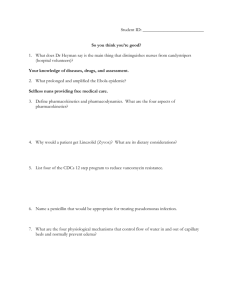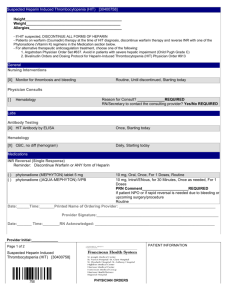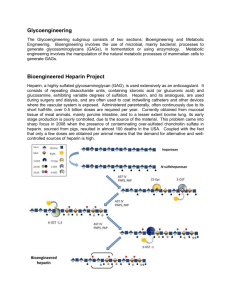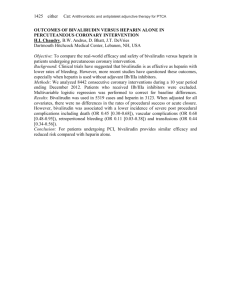PARENTERAL ANTICOAGULANTS
advertisement
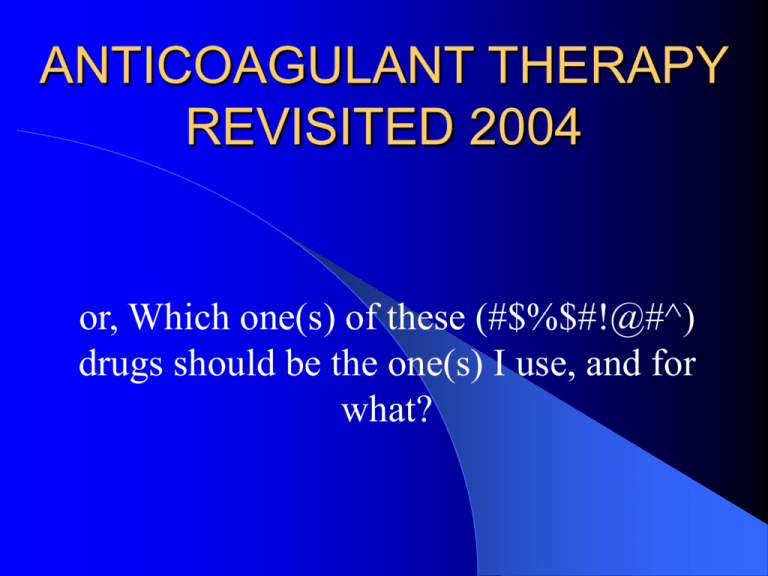
ANTICOAGULANT THERAPY REVISITED 2004 or, Which one(s) of these (#$%$#!@#^) drugs should be the one(s) I use, and for what? ANTICOAGULANT THERAPY One of most common treatments in hospital & out 2nd most common cause of iatrogenic complications (behind only infections) 2nd most expensive source of increased hospital stays ANTICOAGULANT THERAPY Focus on venous thromboembolism (VTE) Focus on parenteral therapy Not topics for discussion today: – Thrombolytic therapy Oral anticoagulants (warfarin) & new agents @ end ANTICOAGULANT THERAPY Goals of Therapy PREVENTION OF FURTHER THROMBOEMBOLISM!!! Stop propagation of clot Prevent formation of further clot Allow dissolution of clot Can be used for prophylaxis against clot formation Anticoagulant Therapy Hemorrhage is a complication of overaggressive anticoagulant therapy Thrombosis is a complication of underaggressive anticoagulant therapy Prophylaxis vs TE Disease Requires smaller dose than does treatment Less risk of bleeding with prophylaxis doses Stratified by risk of developing thromboembolic disease In surgery patients, pre-op therapy generally more effective than post-op therapy (with one exception) Prophylaxis vs TE Disease Low Risk – Minor procedure, otherwise healthy – No medications; rapid mobilization Moderate Risk – Abdominal surgery, thoracic surgery, Medical patient – Multiple medical regimens effective High Risk – Paraplegic, hemiplegic, pelvic surgery, leg surgery – Moderate risk therapy ineffective; more clearly needed Available Anticoagulants Before 1987, only heparin and warfarin were available Now, – 4 low molecular weight heparins (3 available in US) – 1 heparinoid (not available in US) – 1 Factor Xa inhibitor – 3 direct thrombin inhibitors – 1 coumarin derivative More to come Heparin Potentiates inactivation of activated enzymes of clotting cascade, via binding to antithrombin III Functions as chemical catalyst Natural heparin-like molecules on endothelial surfaces make these surfaces antithrombotic in nature Commercially available x 50+ years Lots of knowledge RE: use of drug Heparin Multiple sources – most commonly used are porcine intestine and bovine lung Short-acting (1/2 life c. 1 hour) Bioavailability is variable from source to source & from batch to batch Monitoring usually considered to be necessary to assess the effect of treatment Heparin Monitoring important to ensure that the desired anticoagulant effect is being achieved; NOT to avoid giving too much heparin!!!! Heparin Multiple studies show that in treatment of thromboembolic disease, failure to achieve anticoagulant effect within 48 hours of beginning treatment with ANY medication increases complication rate by 4-10X NO study shows that keeping any monitoring test below a certain level results in decreased bleeding complications HEPARIN Treatment Regimens Prophylaxis vs. DVT – 5000 units SQ BID – Doesn’t require monitoring – Clearly effective in preventing venous thromboembolism in low & moderate risk patients – Doesn’t increase risk of hemorrhage HEPARIN Treatment Regimens – pre1990’s Treatment of thromboembolic disease – Heparin 5000 unit bolus – Continuous infusion at 800-1000 units/hr – Measure aPTT @ 6 hours post-bolus – Adjust up or down to maintain heparin at 1.5- 2.5 x normal aPTT value HEPARIN THERAPY Problems - Prophylaxis Prophylaxis only effective in low or moderate risk groups; ineffective in patients at high risk of VTE (risk of VTE 35-50%) – – – – – Lower extremity orthopedic surgery Radical pelvic surgery Paraplegia/quadriplegia Hemiplegia ? Prothrombotic conditions Higher dose heparin more effective, but requires monitoring, & risk of bleeding increased HEPARIN Problems - Therapy Most patients with formed thrombus are relatively heparin resistant Generally requires 15-20 units heparin/kg/hour to achieve therapeutic aPTT in VTE patients In normal sized adult, often takes several days to get patient therapeutic on heparin HEPARIN Problems - Therapy If > 48 hours to therapeutic range, risk of complications of Rx rise 4-10x & stay up x 6 months Longer to therapeutic causes increased risk of HIT/HITTS Longer to therapeutic increases risk of length-of-stay police HEPARIN THERAPY (VTE) Standard of care: Weight based heparin Various protocols, but all start at 13-18 units heparin/kg/hr, up to a weight of 100-125 kg On these, can achieve therapeutic levels 9095% of the time within 48 hours Still need to get aPTT values in a timely fashion Low Molecular Weight Heparins Higher bioavailability; makes dosing without monitoring a reality (except in renal disease, morbid obesity, cachexia) Longer half-life; therefore can be given subcutaneously1-2x/day Much lower (but not 0) risk of de novo thrombocytopenia At least as effective for treatment; more effective for high risk prophylaxis than heparin Mechanism of action similar to heparin Low Molecular Weight Heparins - Problems More expensive than heparin Longer acting, and only partially reversible with protamine Renally excreted, making dosing problematic in renal disease Cross-reactive with HIT causing antibodies Much more effective for prophylaxis if given preop All carry black box warning vs. use with regional anesthesia LOW MOLECULAR WEIGHT HEPARINS Work best as prophylactic agents when given preoperatively Cannot be given in setting of regional anesthesia (incidence of epidural hematomas noted in this setting) When given post-op, offer little advantage over prophylactic dose heparin or adjusted dose warfarin for DVT prevention Low Molecular Weight Heparins (US) Enoxaparin (Lovenox®) – Approved for VTE prophylaxis, VTE treatment, acute coronary syndrome) Dalteparin (Fragmin®) – Same as enoxaparin RE: approvals, except for VTE treatment Tinzaparin (Innohep®) – Approved for treatment of VTE Ardeparin (Normiflo®) – Not being marketed in US All behave similarly, but dosing of each is different FACTOR Xa INHIBITOR Fondaparinux (Arixtra®) – Semisynthetic sulfated pentasaccharide; active moiety of heparin Only inhibits factor Xa Bioavailability virtually 100%; can be given QD No thrombocytopenia seen in trials (does not bind to platelet factor IV) Data clearly shows it to be superior to LMWH when given postoperatively, & probably superior to LMWH given preoperatively FONDAPARINUX Offers possibility of post-op prophylaxis against DVT with same or better efficacy as preop administration of LMWH Small but real incidence of wound hematomas (nil if given > 6 hrs post-op); bleeding risk otherwise similar to LMWH Avoids problems with administration of drug during regional anesthesia, since can be given after the epidural catheter is pulled Studies for Rx of VTE ongoing Direct Thrombin Inhibitors Block active site of thrombin Inhibit both clot-bound and free thrombin More potent inhibitors than heparin All are short-acting, IV infusions Direct Thrombin Inhibitors Lepirudin (Refludan®) – Hirudin derivative – Half life 30-40 minutes – Problematic in renal disease – Not reversible – Approved for Heparin-Induced Thrombocytopenia and Thrombosis Direct Thrombin Inhibitors Argatroban® – Small molecule active site blocker of thrombin – Half life 30-40 minutes – Problematic in liver disease – Not reversible – Approved for Heparin-Induced Thrombocytopenia and Thrombosis & for Acute Coronary Syndromes Direct Thrombin Inhibitors Bivalirudin (Angiomax®) – Hirudin derivative – Short-acting – Not reversible – Approved for unstable angina/angioplasty HEPARIN-INDUCED THROMBOCYTOPENIA Type II - Treatment Warfarin alone can lead to increased thrombosis Low molecular weight heparin has significant cross-reactivity with anti-heparin antibodies, and can lead to recurrent thrombocytopenia and thrombosis Ancrod, prostacyclin analogues ineffective Current Recommendations In OR: Unfractionated heparin In ICU – Treatment of VTE: Unfractionated heparin, weight-based – Reversibility in these settings critical, as is short duration of action Current Recommendations Acute coronary syndromes – Enoxaparin superior to dalteparin, which is marginally superior to unfractionated heparin Differences small In institutions with aggressive intervention programs, unfractionated heparin remains drug of choice for most cardiologists Current Recommendations On Ward, Rx of VTE: – Unfractionated heparin, weight based – Low molecular weight heparin, weight based (treatment dosing) Enoxaparin, dalteparin, tinzaparin probably equivalent, at appropriate doses Current Recommendations Either can be used; I prefer the latter, except in renal insufficiency – Decreased incidence of HIT – Decreased incidence of subtherapeutic values – Decreased problems with laboratory monitoring of therapy Current Recommendations Outpatient Treatment of VTE – Low molecular weight heparin – Enoxaparin, Dalteparin, Tinzaparin equivalent – ? Role for fondaparinux (at 7.5 mg QD) – Converting to oral agent problematic (mostly because of health care systems) – Financial disincentive for physicians to do this Current Recommendations – VTE Prophylaxis Low Risk – No medications; early ambulation Moderate Risk (Medical or Surgical) – Enoxaparin 40 mg SQ QD or Dalteparin 5000 units SQ QD; ± pneumatic compression Current Recommendations – VTE Prophylaxis (Controversial) Avoid SQ heparin except in severe renal dysfunction SQ heparin equally effective as LMWH in these situations; however, – In prophylaxis, no need to take risk of HIT ?? – extra cost of LMWH outweighed by cost of only a few cases of HIT Current Recommendations – VTE Prophylaxis High Risk Patients – Fondaparinux 2.5 mg SQ QD (especially in the perioperative setting) – Enoxaparin 30 mg SQ Q 12h – Adjusted dose warfarin (begin 1 day pre-op and maintain INR at 1.5-2) – Adjusted dose heparin – to maintain midpoint aPTT at 1.5 x control Current Recommendations – HIT/HITTS Lepirudin if patients don’t have renal disease Argatroban if patients don’t have liver disease AVOID warfarin alone!! WARFARIN Goal - Prevention of further thromboembolism, while minimizing risk of bleeding as much as possible WARFARIN Monitoring International Normalized Ratio (INR) should be used for all monitoring of warfarin therapy – INR=(PTI)ISI; ISI is a fudge factor that corrects for differences in reagents between different laboratories INR Values: 2-3 for most patients; 2.5-3.5 for prosthetic valves; ? Higher for hypercoagulation disorders (controversial) WARFARIN Acute Treatment Can start warfarin once therapeutic on heparin or LMWH Delayed onset of action; need to be covered with parenteral anticoagulant for a minimum of 5 days, or until INR is therapeutic for a minimum of 48 hours, WHICHEVER IS LONGER!!! WARFARIN Acute Treatment No Loading Dose Effect of dose of warfarin seen 36 hours later Multiple meds affect sensitivity to warfarin Final adjustment needs to be done as an outpatient, but should get into therapeutic range before leaving hospital WARFARIN Duration of Therapy Post-operative DVT’s, no risk factors – 6 weeks warfarin therapy First DVT, no risk factors for thrombosis, NOT post-op – 6 months warfarin therapy; ? Indefinite Rx, ? at lower INR range Second or greater DVT – Indefinite warfarin unless major contraindication Future Agents (Not yet approved) Melagatran/Ximelagatran – Direct thrombin inhibitors; 2nd drug is orally active, & could potentially replace warfarin ? Other direct thrombin inhibitors for uses other than HIT ? Orally active heparin/LMWH derivatives




